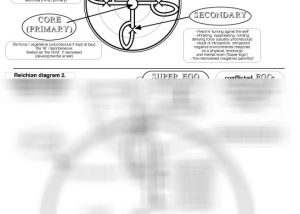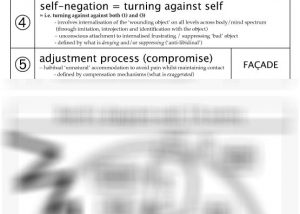Some years after I had formulated my critique and misgivings about the application of character structure theory in traditional Body Psychotherapy, I was asked to give my own updated summary of the different character styles, in this chart is the result. This is now more than 10 years [...]

Clarkson’s 5 Modalities of the Therapeutic Relationship – extended to 7 (1998)
Michael - Handouts2017-04-07T02:59:01+00:00This is my own version of the extension of 5 modalities to 7, to include 'medical model' relating and archetypal relating (based upon Hillman's 'The Myth of Analysis'). Other therapists have suggested the intercultural level of relating as a 6th modality. This makes some sense (as cross-cultural relatedness [...]

The Therapeutic Position in the Conflict between Colluding and Objectifying (1997)
Michael - Handouts2017-04-07T02:58:56+00:00This handout is the original formulation how the client's internal conflict necessarily puts the therapist in conflict. The client's chronic conflict is formulated here in generic terms as a polarised split between 'habitual mode' and 'emergency' (usefully alluding to both the client's denied sense of emergency as well [...]

The Client’s Conflict becomes the Therapist’s Conflict (1998)
Michael - Handouts2017-04-07T02:58:50+00:00This handout is a later version of the original formulation how the client's internal conflict necessarily puts the therapist in conflict. The client's chronic conflict is formulated here in generic terms as a polarised split between 'habitual mode' and 'emergency' (usefully alluding to both the client's denied sense [...]

Types of Countertransference (after John Rowan – Critique) (1996)
Michael - Handouts2017-04-07T02:58:36+00:00The following list of types of countertransference was first published more than 30 years ago, by one of the elders of the humanistic tradition in the UK, John Rowan. He was then already modelling an interest and learning from the psychoanalytic tradition, trying to bring a more straightforward [...]

5 Parallel Relationships (early version) (1996)
Michael - Handouts2017-04-07T02:58:24+00:00This handout is a more complex elaboration of the previous one, based upon further distinguishing the internal object relations (i.e. the ways in which the client is relating to themselves, and the multiple self states involved) into three further parallels: 1. conflicting dynamics within the ego (similar to [...]
3 Parallel Relationships (1996)
Michael - Handouts2017-04-07T02:58:16+00:00This handout is fundamental to a relational conception of therapy, recognising the parallels between past, internal and external relationship dynamics. It is similar to Michael Jacob's seminal psychodynamic textbook ""The Presenting Past"", but based on an understanding of character formation, internalisation of the past wounding relationship, the continuing [...]

Petruska Clarkson’s ‘Five Modalities of the Therapeutic Relationship’ (1995)
Michael - Handouts2017-04-07T02:58:12+00:00This handout is a simple summary in table form of the modalities of the therapeutic relationship, as initially formulated by Petruska Clarkson in her seminal 1991 paper: ""Clarkson, P (1991) A Multiplicity of Psychotherapeutic Relationships, in British Journal of Psychotherapy, 7: 2"". This was later elaborated in her [...]

The Implicit Relational Stance Underlying Theory and Technique (1995)
Michael - Handouts2017-04-07T02:58:00+00:00This is a more detailed updated version of this handout (earliest version 1995). I had been working with the notion of the therapist's 'habitual position' since the mid-1990s, after we had recognised for some years that students were attracted to our training both for very good and for [...]

Levels of BodyMind – BODY – EMOTION – IMAGINATION – MIND – INTUITION (1995)
Michael - Handouts2017-04-07T02:57:52+00:00This handout is an attempt to appreciate the many subtleties and layers we can distinguish in terms of bodymind process, reaching from the most basic physiological via the emotional, imaginal and mental toward intuition. We can think of these levels as multiple intelligences, or different kinds of consciousness. [...]
Character Formation – 5 Steps (1995)
Michael - Handouts2017-04-07T02:57:45+00:00This is a slightly reformulated version of Stephen Johnson's 5 steps of character formation. These five steps are the basic process by which developmental, relational injury occurs and leads to 'turning against the self' and chronic character formation. While rooted in Reich's character analysis, Johnson has drawn from [...]
Character Formation (1995)
Michael - Handouts2017-04-07T02:57:32+00:00This is a summary of the previous two handouts on one page - both a description of the 5 steps of character formation and Reich's diagram of an impulse 'turning back against itself', using terms from Transactional Analysis. This early version is in line with a traditional conceptualisation [...]

Character Formation: Reich’s diagram of ‘turning against self’ (1995)
Michael - Handouts2017-04-07T02:57:40+00:00This is Reich's diagram of an impulse 'turning back against itself'. This diagram is easier to understand if we illustrate it with terms drawn from Transactional Analysis. Turning against the self in character formation implies chronic internal conflict, based on internalisation of an external conflict and - it [...]
Three Kinds of Contact (1995)
Michael - Handouts2017-04-07T02:57:20+00:00This handout is one of the most basic and fundamental to a relational perspective on therapy. If it is indeed 'the relationship that matters', what kinds of contacts can exist between client and therapist? Alongside the different modalities of therapeutic relatedness, we can recognise the coming and going [...]
Three Kinds of Contact (1995, simple)
Michael - Handouts2017-04-07T02:57:13+00:00This handout is one of the most basic and fundamental to a relational perspective on therapy. If it is indeed 'the relationship that matters', what kinds of contacts can exist between client and therapist? Alongside the different modalities of therapeutic relatedness, we can recognise the coming and going [...]

Perception Understanding Intervention (1994)
Michael - Handouts2017-04-07T02:58:29+00:00Perception, understanding and therapeutic response/intervention are shaped by the therapist's implicit relational stance (in the paradigm clash between the polarities of 'medical model' versus 'anti-medical model', and integrated by a third paradoxical position: holistic-systemic-relational). After using earlier and more confused versions of this handout during the early 1990's, [...]

The Gestalt Cycle (including typical contact disturbances) (1992)
Michael - Handouts2017-04-07T02:57:05+00:00This handout is a modern version of the cycle of Gestalt formation and destruction - the way new experiences move into the foreground, become figural, are engaged with and then eventually lose interest. In this modern diagram (based upon Clarkson/Sills/Lapworth), the stages of the cycle and the typical [...]

Maps of Wholeness – E.F. Schumacher’s ‘Four Fields of Knowledge’ (1992)
Michael - Handouts2017-04-07T02:56:58+00:00I have included some handouts based upon E.F. Schumacher's brilliant little book ""A Guide for the Perplexed"" (1977) - written towards the end of his life in presenting a distillation of basic his beliefs and principles. His distinction of the 4 fields of human knowledge predates Wilber's four [...]

Character Formation – 5 Steps (early version 1992)
Michael - Handouts2017-04-07T02:56:40+00:00This handout combines a more detailed version of 5 steps of character formation as formulated by Stephen Johnson (see ""Character Styles"" 1994), but based on Wilhelm Reich and Alexander Lowen, with Reich's diagram of an impulse turning back against itself. This diagram is easier to understand if we [...]

Character Formation – Primary, Secondary, Facade (early version 1992)
Michael - Handouts2017-04-07T02:56:52+00:00This handout combines Reich's diagram of a blocked and repressed impulse (the 'turning-against-the-self') with the three layers of character armour. In this handout the three layers are explained in some detail (top half of page). This diagram is easier to understand if we illustrate it with terms drawn [...]





